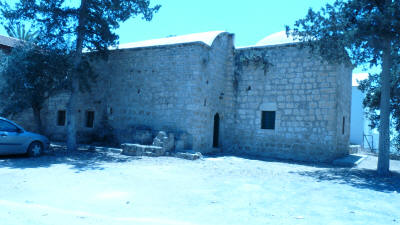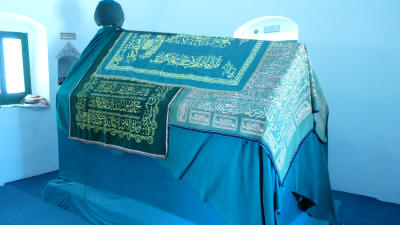Tekke of Kutup Osman
Famagusta, North Cyprus
 |
| The Tekke of Kutup Osman |
This is situated a few hundred yards outside the walled city, opposite the First Train, and inside the grounds of the Namik Kemal High School.
Kutup Osman Fazli Efendi was the leader of the Halvetiye sect. He was born on the 7th July 1632 in Shumnu in present day Bulgaria, but then part of the Ottoman empire. His father was a learned person, who to ensure his son had a good education, did it himself. His father died when he was about ten, and for a while Ozman Fazli ceased his studies.
Something, however, prompted him to resume his studies in a spiritual direction, and with his mother's permission, he moved to Edirne, at the time the second capital of the Ottoman empire. Here he was tutored by Ibrahim Efendi who from an early aage had been a companion of Sultan Ahmet I, and had been a pupil of the founder of the Halvetiye order, which he now represented in Edirne.
Osman Fazli then moved to Istanbul to continue his religious education at the main Halveti tekke, after which he set out on a life of preaching and calling people to God. By the age of 41, Ozman Fazli had become leader of the Halvetiye sect.
 |
| Kutup Osman's Sarcophagus |
By the 1680s man Fazli was on good terms with Sultan Mehmet IV, who had been ruling for more than 30 years. However, it was the Grand Vizier who, much the same as the British Prime Minister, held the reigns of state. When the Grand Vizier wanted to break the treaty between the Ottoman empire and the Holy Roman Empire, Osman Fazli strongly argued against it, claiming it could only lead to disaster and misfortune. He was proven to be right. The Grand Vizier was executed, the Ottomans lost Buda in 1686 and Belgrade in 1688. In 1687, the military revolted, and Mehmet IV dethroned in favour of his brother Suleyman II.
Ozman Fazli was offered the Grand Viziership, and although he refused, he continued to exercise considerable influence on the Sultan. His strict adherence to his principals didn't make him many friends in high places, particularly when attempting to find passages in the Koran to justify new taxes, and he was banished to his home town of Shumnu for a short time, and in 1690 he was further exiled to Famagusta where he died in 1691.
Over the centuries, his tekke fell into disrepair, and it was rebuilt in 1824. Here his sarcophagus lies in a simple room, giving him the obscurity in death that he so sought in life.
See the location on Google maps.
Back to Famagusta index.